
C. Müller et al. / Case Reports in Clinical Medicine 2 (2013) 310-314 313
mation can play an important role in manifestation of
primary APS that requires consequent immunosuppres-
sant treatment. Inflammation and anticoagulation have to
be monitored by D-Dimer values, CRP values and spe-
cific tests that depend upon the regiments.
A critical cardiopulmonary monitoring including echo-
cardiography, ECG, spirometry, CPX and Holter ECG is
necessary to recognize pulmonary hypertension and de-
creased endurance of the patient. Cardiac limitations due
to pulmonary hypertension may be treated by endarter-
ectomy or endothelin receptor antagonist, if patients are
deemed inoperable.
In patients with only pulmonary limitations like in our
case inhaled corticosteroid seems to be a good course of
treatment.
REFERENCES
[1] von Scheven, E., Glidden, D.V. and Elder, M.E. (2002)
Anti-beta2-glycoprotein I antibodies in pediatric systemic
lupus erythematosus and antiphospholipid syndrome. Ar-
thritis & Rheumatism, 47, 414-420.
doi:10.1002/art.10510
[2] Espinosa, G., Cervera, R., Font, J. and Asherson, R.A.
(2002) The lung in the antiphospholipid syndrome. An-
nals of the Rheumatic Diseases, 61, 195-198.
doi:10.1136/ard.61.3.195
[3] Asherson, R.A., et al. (1998) Catastrophic antiphospho-
lipid syndrome. Clinical and laboratory features of 50 pa-
tients. Medicine (Baltimore), 77, 195-207.
doi:10.1097/00005792-199805000-00005
[4] Asherson, R.A. and Cervera, R. (1995) Review: Anti-
phospholipid antibodies and the lung. Journal of Rheu-
matology, 22, 62-66.
[5] Cervera, R., et al. (2009) Morbidity and mortality in the
antiphospholipid syndrome during a 5-year period: A
multicenter prospective study of 1,000 patients. Annals of
the Rheumatic Diseases, 68, 1428-1432.
[6] Olivier, C., Blondiaux, E., Blanc, T., Borg, J.Y. and Da-
cher, J.N. (2006) Catastrophic antiphospholipid syndrome
and pulmonary embolism in a 3-year-old child. Pediatric
Radiology, 36, 870-873. doi:10.1007/s00247-006-0183-5
[7] Porres-Aguilar, M., Pena-Ruiz, M.A., Burgos, J.D., Por-
res-Munoz, M. and Hughes, H.W. (2008) Chronic throm-
boembolic pulmonary hypertension as an uncommon pre-
sentation of primary antiphospholipid syndrome. Journal
of the National Medical Association, 100, 734-736.
[8] Espinosa, G., Bucciarelli, S., Asherson, R.A. and Cervera,
R. (2008) Morbidity and mortality in the catastrophic an-
tiphospholipid syndrome: Pathophysiology, causes of death,
and prognostic factors. Seminars in Thrombosis and He-
mostasis, 34, 290-294. doi:10.1055/s-0028-1082274
[9] Tan, E.M., et al. (1982) The 1982 revised criteria for the
classification of systemic lupus erythematosus. Arthritis
& Rheumatism, 25, 1271-1277.
doi:10.1002/art.1780251101
[10] Hochberg, M.C. (1997) Updating the American College
of Rheumatology revised criteria for the classification of
systemic lupus erythematosus. Arthritis & Rheumatism,
40, 1725. doi:10.1002/art.1780400928
[11] Petri, M. (2005) Review of classification criteria for sys-
temic lupus erythematosus. Rheumatic Disease Clinics of
North America, 31, 245-254.
doi:10.1016/j.rdc.2005.01.009
[12] Gaubitz, M. and Schotte, H. (2005) Early diagnosis in
patients with systemic lupus erythematosus (SLE). Zeits-
chrift für Rheumatologie, 64, 547-552.
doi:10.1007/s00393-005-0795-4
[13] Gertner, E. and Lie, J.T. (1993) Pulmonary capillaritis,
alveolar hemorrhage, and recurrent microvascular throm-
bosis in primary antiphospholipid syndrome. Journal of
Rheumatology, 20, 1224-1228.
[14] Lim, W., Crowther, M.A. and Eikelboom, J.W. (2006)
Management of antiphospholipid antibody syndrome: A
systematic review. JAMA, 295, 1050-1057.
doi:10.1001/jama.295.9.1050
[15] Crowther, M.A., et al. (2003) A comparison of two inten-
sities of warfarin for the prevention of recurrent thrombo-
sis in patients with the antiphospholipid antibody syn-
drome. New England Journal of Medicine, 349, 1133-
1138. doi:10.1056/NEJMoa035241
[16] Ruiz-Irastorza, G., Hunt, B.J. and Khamashta, M.A. (2007)
A systematic review of secondary thromboprophylaxis in
patients with antiphospholipid antibodies. Arthritis & Rheu-
matism, 57, 1487-1495. doi:10.1002/art.23109
[17] Castro, P., et al. (2003) Catastrophic antiphospholipid
syndrome and acute heart failure. Report of a case. Re-
vista Medica de Chile, 131, 1037-1041.
doi:10.4067/S0034-98872003000900010
[18] Huang, H.J., Wang, J.N., Tsai, Y.C., Lin, C.S. and Wu,
J.M. (2002) Intrapulmonary thrombolytic therapy in a
child with acute pulmonary embolism due to primary an-
tiphospholipid syndrome. Acta Paediatrica Taiwanica, 43,
351-353.
[19] Kim, W.J., Hong, Y.K. and Yoo, W.H. (2008) Epidural
hematoma mimicking transverse myelitis in a patient with
primary antiphospholipid syndrome. Rheumatology In-
ternational, 28, 709-712. doi:10.1007/s00296-007-0512-5
[20] Ordi-Ros, J., Perez-Peman, P. and Monasterio, J. (1994)
Clinical and therapeutic aspects associated to phosphol-
ipid binding antibodies (lupus anticoagulant and anticar-
diolipin antibodies). Haemostasis, 24, 165-174.
[21] Cherian, J. and Gertner, E. (2005) Recurrent pulmonary
embolism despite inferior vena cava filter placement in
patients with the antiphospholipid syndrome. Journal of
Clinical Rheumatology, 11, 56-58.
doi:10.1097/01.rhu.0000152150.01274.1b
[22] Zifman, E., Rotman-Pikielny, P., Berlin, T. and Levy, Y.
(2009) Insertion of inferior vena cava filters in patients
with the antiphospholipid syndrome. Seminars in Arthri-
tis and Rheumatism, 38, 472-477.
[23] Palareti, G., et al. (2006) D-dimer testing to determine the
duration of anticoagulationtherapy. New England Journal
of Medicine, 355, 1780-1789.
doi:10.1056/NEJMoa054444
Copyright © 2013 SciRes. OPEN ACCESS